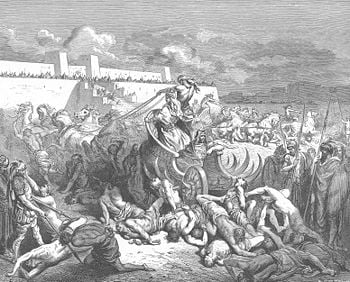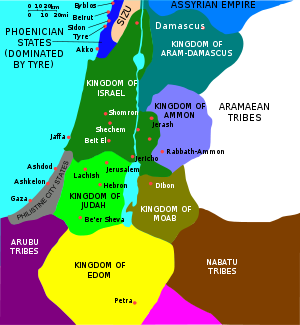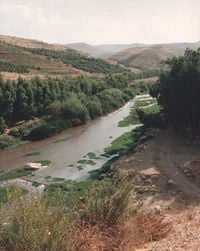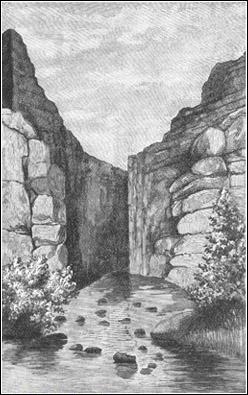Ammon
The nation of Ammon or the Ammonites were a people living east of the Jordan river whose origin in the Old Testament traces to Lot, the nephew of the patriarch Abraham. Because of their kinship with Abraham, the Ammonites were not listed among the peoples whom the Israelites were supposed to drive out of Canaan. The Bible stipulates that they were given their land by God, who helped them defeat its giant-like earlier inhabitants. However, disputes over territory led to frequent warfare between the Ammonites and Israelites.
In the time of the judges, the Ammonites and Israelites engaged in various battles, and the Ammonites were characterized by the biblical writers as one of God's instruments to punish Israel for its sins. After suffering military defeats in the time of Saul and David, the Ammonites became vassals of Judah and Israel. During the time of Solomon, an Ammonite princess named Naamah was the Israelite king's chief wife and mother of his heir. To honor her, Solomon created an altar to the Ammonite god Molech.
The Ammonites occasionally rebelled against their Hebrew overlords, usually to their detriment. They later helped the Babylonians defeat Judah and were subsequently rejected by the Jews and forbidden to intermarry with them, although this may not have been strictly enforced. Although they left few historical records, the Ammonites survived well into the second century C.E.. Their capital city of Rabbah was located close to todays' Amman, Jordan. Though rarely mentioned in Christian tradition, Jesus' lineage was partly Ammonite.
Territory
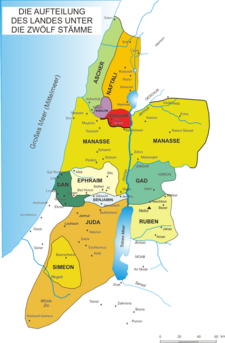
The kingdom of Ammon was located in northwestern Arabia east of Gilead in what is today called Jordan and Syria.[1] However, the Ammonites also claimed territories east of the Jordan that were occupied by the Israelites. The borders of the Ammonite territory are not uniformly defined in the Old Testament and no doubt fluctuated as the results of warfare over the centuries.
The western border of Ammon was often a matter of dispute between Ammon and Israel. In Judges 11:13, the king of Ammon demanded the restoration of the land "from Arnon even unto Jabbok and unto Jordan." This claim was rejected by Israel on the grounds that the Israel had taken the land not from Ammon but from the Amorites. The other limits of Ammonite territory are even less clear. On the south, it adjoined the land of Moab. On the north, it may have met that of the king of Geshur (Joshua 12:5) and later Damascus, while in the east it apparently merged into the desert peopled by Aramean nomadic tribes.
The chief city of the Ammomites was Rabbah or Rabbath Ammon. The modern city of Amman, Jordan, is located roughly at its site.[2]
History
Descent
The main source of our knowledge about the Ammonites comes from their enemies, the Israelites, and must be understood as written from a point of view that is often hostile. Records from other middle eastern sources are scarce. The Ammonites themselves left few if any records that shed information on their history.
According to the pedigree given in Book of Genesis 19:37-38, the Ammonites were closely related to the Israelites and still more closely to their neighbors to the south, the Moabites. However, the story also shows the contempt which the Hebrews felt toward the Ammonites, as it portrays them as the descendants of Ben-Ammi ("Son of my People"), the son of Lot through incest with his own daughter. The Moabites were supposedly descended from Ben-Ammi's brother, Moab. Whether these were historical figures or legendary ones is questioned by critical scholars.
The Ammonites are thus portrayed in the Bible as the Israelites' cousins, who grew into a nation after the Israelites left Canaan to live in Egypt in the time of Jacob. As they expanded, the Ammonites are said to have defeated the Rephaites, also called Zamzummites, a race of giant-like warriors who were driven out of the land by the Ammonites with the help of Yahweh (Deuteronomy 2:21). However, the Bible criticizes the Ammonites for not aiding the Israelites of the Exodus on their way to Canaan. The progeny of Ammonites are excluded from full membership in the community of Israel until the "tenth generation," on the grounds that it was they and the Moabites who hired the prophet Balaam to curse Israel (Deuteronomy 23:3-4).[3]
Nevertheless, the Ammonites are specifically protected from territorial encroachment by the Israelites. Deuteronomy 2:19 specifies:
When you come to the Ammonites, do not harass them or provoke them to war, for I will not give you possession of any land belonging to the Ammonites. I have given it as a possession to the descendants of Lot.
Ammon vs. the Israelites
After leaving Egypt, the Israelites reportedly discovered the Amorite king Sihon in possession of Gilead, the country on the east bank of the Jordan, to the north of the Arnon river (Numbers 21:13). After defeating Sihon, the Israelites claimed the land as theirs. The Ammonites, however, did not accept either Sihon's or Israel's right to this land. In the resulting warfare, the Iraelites drove the Ammonites across the upper waters of the Jabbok river, where it flows from south to north, which continued to be their western boundary in the biblical reckoning (Numbers 21:24; Deuteronomy 2:37 and 3:16), though not in their own opinion. In the time of the judges, the tribes of Gad and Gilead (a part of the tribe of Manasseh) possessed lands that continued to be claimed by Ammon.
In Judges, 3:13, the Ammonites furnished assistance to King Eglon of Moab against Israel. They are also the primary antagonists against the combined forces of Judah, Benjamin, Ephraim, and Gilead in the saga of the judge Jephthah.
Ammon vs. Saul and David
In the days of the the prophet Samuel, the Ammonite leader Nahash besieged the town of Jabesh-Gilead, east of the Jordan. This prompted its inhabitants to call on "Israel" for aid. The incident became the impetus behind the unification of the tribes under Saul, who defeated the Ammonites and was thus confirmed as king (1 Samuel 11:11-14). In Samuel's, "farewell speech," he indicates that it was the threat of aggression from Nahash that prompted Israel to ask him for a king (1 Samuel 12:12).
From 2 Samuel 10:2, it may be concluded that Nahash assisted the fugitive David while Saul was still king. However, Nahash's son Hanun provoked David by ill-treating his ambassadors and thus brought about the utter defeat of the Ammonites, despite assistance from their northern neighbors in Aram. David sent his army against the Ammon under the command of his general, Joab. The Ammonites allied themselves with Aramean (Sryian) forces under Hadadezer, but to no avail: "When all the kings who were vassals of Hadadezer saw that they had been defeated by Israel, they made peace with the Israelites," leaving Ammon to fend for itself (2 Sam 10:19).
While David remained in Jerusalem to dally with Bathsheba, Joab led the Israelite army against the Ammonite forces at Rabbah. It was here that the Israelite commander Uriah the Hittite was infamously slain by David's treachery (2 Sam 11). Joab besieged the city and finally took its citadel, inviting David to join the battle at the last moment and take credit for bringing about the city's fall.
The Ammonite capital was apparently a wealthy one, as its king's gold crown is described as weighing a talent (75 pounds). David also "took a great quantity of plunder from the city." Like the Egyptian pharaohs had done to the Israelites, David enslaved the population of the Ammonite towns and may have set them to brick-making (2 Sam. 12). However, depending on the translation of the passage, he may have punished the Ammonites much more harshly than this:
- He also brought out the people who were in it, and set them under saws, sharp iron instruments, and iron axes, and made them pass through the brick-kiln. And thus he did to all the cities of the sons of Ammon (2 Sam. 12:21).
Relations with Judah and Israel
After this, the new Ammonite ruler was Shobi, a brother of Hanun, who was evidently appointed by David as his vassal. During David's flight from Jerusalem during the rebellion of Absalom, Shobi offered Daivd valuable aid (2 Samuel 17:27). There were also Ammonite mercenaries in David's army.
Solomon's chief wifeâthe mother of his heirâwas Naamah, an Ammonitess (1 Kings, 14:21), probably a daughter of Shobi. She became the mother of Rehoboam, implying that the Davidic kings all had Ammonite blood (1 Kings 14:31). Solomon honored his alliance with Ammon by erecting an altar to the Ammonite god Molech (1 Kings 11:7), an act which lost him the support of the Jerusalem priesthood and prophets of Yahweh.
Hostilities again broke out between Judah and Ammon under Jehoshaphat of Judah (2 Chron. 20). Ammon joined with Moab on this occasion, but in the biblical version of the battle, the forces allied against Judah ended up turning against each other. The Israelites then came upon the slaughter and "there was so much plunder that it took three days to collect it."
From Assyrian inscriptions, we learn that the Ammonite king Ba'sa (Baasha) son of Ruhubi joined Ahab of Israel and his Syrian allies against Shalmaneser III at the Battle of Qarqar in 853 B.C.E.. The Ammonites may at this time have been vassals of Bar-Hadad II, the Aramaean king of Damascus.
The alliance with Israel did not last, however, as Ammon later fought against the northern kingdom during the reign of Jeroboam II (Amos, 1:13), over disputed territory in Gilead. The Ammonites brought tribute to King Uzziah of Judah in 2 Chronicles 26:8, but rebelled under his son Jotham, (2 Chron. 27:5) who defeated them and forced them to pay heavy tribute in silver and crops.
In 734 the Ammonite king Sanipu was a vassal of Tiglath-Pileser III. His successor, Pudu-ilu, held the same position under Sennacherib and Esarhaddon. An Assyrian tribute-list from this period indicates that Ammon paid one fifth the tribute required from Judah, which remained relatively prosperous compared to its poorer neighbor.
Somewhat later, the Ammonite king Amminadab I was among the tributaries who suffered in the course of the great Arabian campaign of Assurbanipal. Other Ammonite kings attested to in contemporary sources found at Heshbon (tel Siran) in Jordan are Barakel and Hissalel, who reigned about 620 B.C.E.
The Ammonites under King Baalis helped the Babylonian monarch Nebuchadrezzar against Jehoiakim of Judah (2 Kings 24:2). On the other hand, some of the Ammonites apparently joined the Judean King Zedekiah's rebellion against Babylon (Jeremiah 27:3), and were threatened by the Babylonian army, (Ezekiel 21:20), but they do not appear to have suffered greatly as a result.
In the time of Nebuchadnezzar, the Ammonites were mercurial in their political attitude. They assisted the Babylonian army against the Jews (2 Kings, 24:2), encroached upon the territory of the Gad, and occupied Heshbon and Jazer (Jeremiah 49:1, cf. Zephaniah 2:8). However, passages in Jeremiah 9:26, 25:21, 27:3, and Ezra, 21:20, point to rebellion by them against Babylonian supremacy. They received Jews fleeing before the Babylonians (Jeremiah 40:11), and King Baalis, instigated the assassination of Gedaliah, the Babylonians' Jewish governor of Jerusalem and its environs.[4]
Subsequent history
Ammonites may have been among the people who offered the Jews help in rebuilding the Temple of Jerusalem, saying "Let us help you build because, like you, we seek your God" (Ezra 4:2). If so, their rejection by Zerubbabel was probably one cause of their later hostility to the effort. Tobiah, an Ammonite (possibly the governor of Ammon), sought to hinder the work (Neh. 3:35). Meanwhile Jews had been forbidden to intermarry with Ammonites, although such marriages were by no means rare (Ezra, 9:1; I Esdras 8:69, and elsewhere).
Little mention is made of the Ammonites through the Persian and early Hellenistic periods. Their name appears, however, during the time of the Maccabees. The Ammonites, with some of the neighboring tribes, did their utmost to resist the revival of the Jewish power under Judas Maccabaeus (1 Maccabees 5:6; cf. Josephus Jewish Antiquities xii.8.1). The Ammonites under Timotheus were defeated by Judas (1 Maccabees 5:6). However, it is possible here that, after the Babylonian Exile, the term "Ammonite" denoted all peoples living in the former country of Ammon and Gad, including Samaritans and others.
The last notice of the Ammonites themselves is in Justin Martyr, Dialogue with Trypho (§ 119), where it is affirmed that they were still a numerous people in the second century C.E..
Economy and language
The frequent assumption that, living on the borders of the desert, the Ammonites remained more pastoral than the Moabites and Israelites, seems to be unfounded (Ezek. 25:4, 2 Chron. 27:5). The environs of Rabbah, at least, were fertile and were tilled. In regard to other cities than Rabbah, see Judges, 11:33; 2 Sam. 12:31.
In modern times, ruined towns were scattered thickly over the area south and east of Rabbah, attesting that it was once occupied by a population that was settled and industrious. This fact is also indicated by the heavy tribute of grain paid annually to Jotham (2 Chr. 27:5) and the Assyrians.
Like its sister-kingdom of Moab, Ammon was the source of numerous natural resources, including sandstone and limestone. It had a productive agricultural sector and occupied a vital place along the king's highway, the ancient trade route connecting Egypt with Mesopotamia, Syria, and Anatolia. As with the Edomites and Moabites, trade along this route gave the Ammonites considerable revenue. Nevertheless, they remained one of the weaker nations in the area, and never became a major military power.
The few Ammonite names that have been preserved testify, in harmony with other considerations, that their language was Semitic, closely related to the Hebrew language and the Moabite language.
Religion
Of the customs, religion, and social structure of the Ammonites, little is known. From the names of their kings, it seems logical that the cult of the Baals probably coexisted in Ammon with that of El. Both Israelite and Ammonite names contain the theorphoric "el" syllable, and a few Israelite names contain "bal" or "baal." The name of the Ammonite governor/king Tobiah suggests that Yahweh may have been worshiped in Ammon as well, although by this time the Jews did not wish to share this worship with them.
In the biblical record, the name of the Ammonites' chief deity is Milcom, sometimes given as Moloch), as in I Kings, 11:5 I Kings, 11:7; II Kings, 23:13. The word is related to the Hebrew word for king, and is sometimes translated as "their king."
No Canaanite, Moabite, or Ammonite records survive that speak specifically of the Ammonite religion. In the Bible, Milcom/Moloch is described as having been worshiped at times by human sacrifice. Jeremiah 32:35 indicates that Moloch was also the object of worship by Israelites living in Jerusalem during his time. The worship of Moloch outside of Ammonite territory reportedly dated back to the time of Solomon, who built an altar to him in honor his Ammonite wife, the mother of Rehoboam.
However, according to Jeremiah, the high places built for the purpose of offering sacrifice to Moloch are described as dedicated to "Baal." This leads the possibility that "Moloch" may have been a title ("king") rather than the name of the Ammonite deity.
Notes
- â Frederick C. Mish, Editor in Chief. âAmmon.â Websterâs Ninth New Collegiate Dictionary. 9th ed. Springfield, MA: Merriam-Webster Inc., 1985. ISBN 0877795088
- â Ibid.
- â However, the biblical story of Balaam mentions only the Moabites in this context (Numbers 22-25).
- â ibid. 40:14, 41:15
ReferencesISBN links support NWE through referral fees
- Landes, George M. A History of the Ammonites; A Study of the Political Life and Material Culture of the Biblical Land of Ammon As an Autonomous State (Ca. 1300-580 B.C.E.). Johns Hopkins University, 1956. OCLC 30730272
- MacDonald, Burton. Ammon, Moab, and Edom: Early States/Nations of Jordan in the Biblical Period (End of the 2nd and During the 1st Millennium B.C.E.). Amman: Al Kutba, 1994. OCLC 32430317
- MacDonald, Burton, and Randall W. Younker. Ancient Ammon. Studies in the history and culture of the ancient Near East, v. 17. Leiden: Brill, 1999. ISBN 9789004107625
- This entry incorporates text from the public domain Easton's Bible Dictionary, originally published in 1897.
- This article incorporates text from the Encyclopædia Britannica Eleventh Edition, a publication now in the public domain.
- This article incorporates text from the 1901â1906 Jewish Encyclopedia, a publication now in the public domain.
External links
All links retrieved July 25, 2023.
- Ammonites Catholic Encyclopedia â www.newadvent.org
Credits
New World Encyclopedia writers and editors rewrote and completed the Wikipedia article in accordance with New World Encyclopedia standards. This article abides by terms of the Creative Commons CC-by-sa 3.0 License (CC-by-sa), which may be used and disseminated with proper attribution. Credit is due under the terms of this license that can reference both the New World Encyclopedia contributors and the selfless volunteer contributors of the Wikimedia Foundation. To cite this article click here for a list of acceptable citing formats.The history of earlier contributions by wikipedians is accessible to researchers here:
The history of this article since it was imported to New World Encyclopedia:
Note: Some restrictions may apply to use of individual images which are separately licensed.
